We usually meet on the last Wednesday of each month at 9:30am by the village hall. Walks are not long or strenuous; 5 or 6 miles on average, each with a different leader. 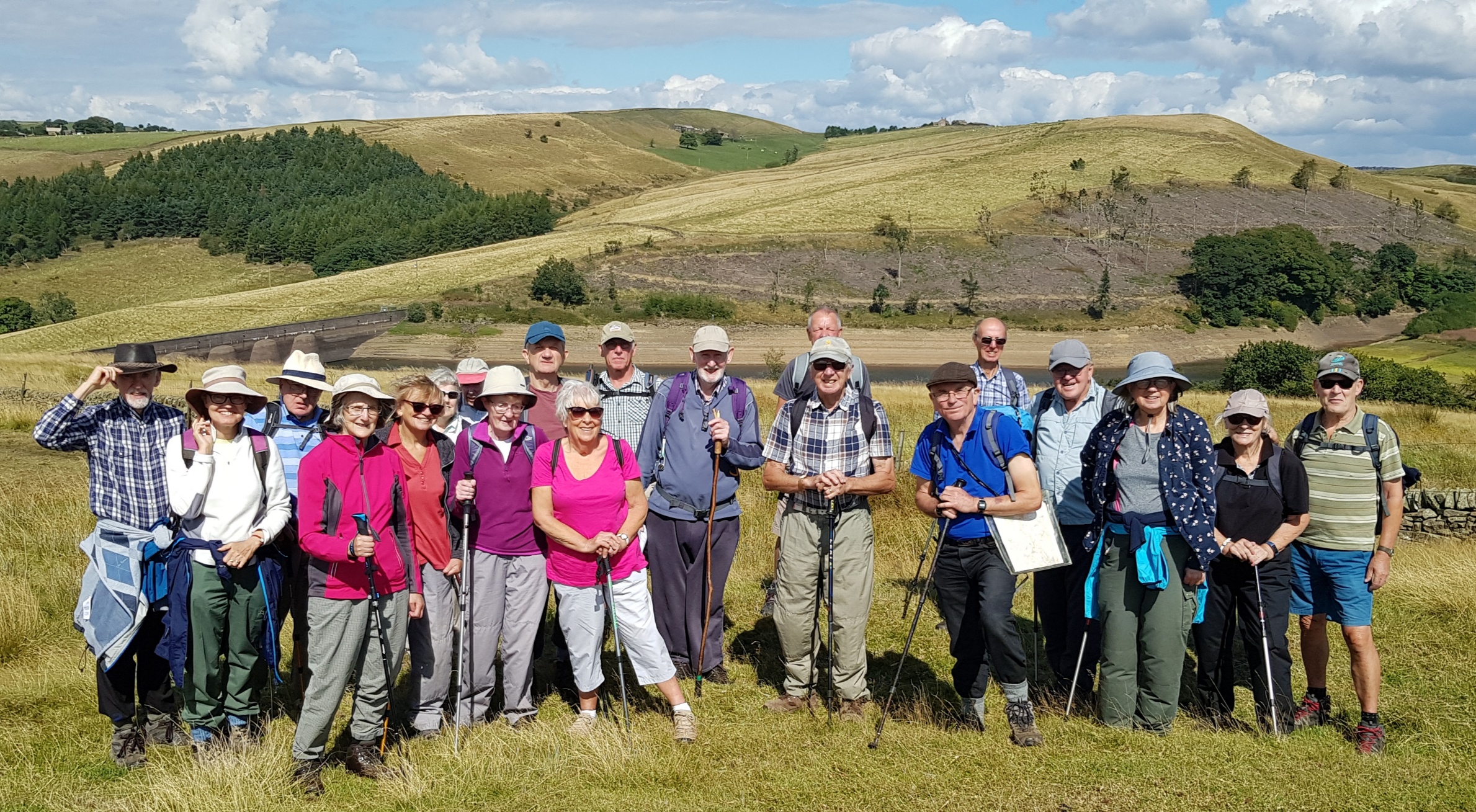 Come along to see the countryside in all its moods, sometimes bathed in sunshine, often with a shower or two, even perhaps with a carpet of snow!
Come along to see the countryside in all its moods, sometimes bathed in sunshine, often with a shower or two, even perhaps with a carpet of snow!
Our walkers might pass stone-age remains, badger setts and tracks, and fascinating old farmhouses and cottages. They will certainly enjoy sweeping views over the Cheshire plain, Peak District panoramas of hills and dales, and gentler scenery by canals and parkland in Lyme, Alderley and Ladybrook.
You are guaranteed a friendly welcome when you join us.
Do come!
Group Leader David Burke
walking@highlaneu3a.org.uk
2023 Walks
Walking Group report 25th January 2023
21 of us met at the Village Hall car park for a “High Lane circumnavigation“, i.e. a walk starting and finishing at the car park, more or less encircling High Lane.
We proceeded along the Macclesfield canal tow path until we reached a footbridge which we crossed. We then continued along a farm track to Platt Wood farm and then on to Elmerhurst cottage. Here we entered Lyme Park. We continued through the park to exit at the main entrance. Here we crossed over the A6 to enter a footpath over some challenging stiles.
There was then a steep climb through some ancient woodland to emerge at the summit of Jacksons Edge Road. We crossed this road and then took another path to Disley Golf Course. We skirted the edge of the golf course, turning onto a narrow road to then across some fields which brought us to the Peak Forest Canal.
We continued along the tow path for nearly a mile, stopping at a low wall, which we could sit on while we ate our packed lunches. We then crossed the canal over a lift bridge to Turf Lea Farm, crossing Wyberslea Road to take a footpath, a farm track and then another footpath to Victoria Cottage on Windlehurst Road.
A short walk along Windlehurst Road to the Macclesfield canal again and then back to the Village Hall.
Jeff Mortimer
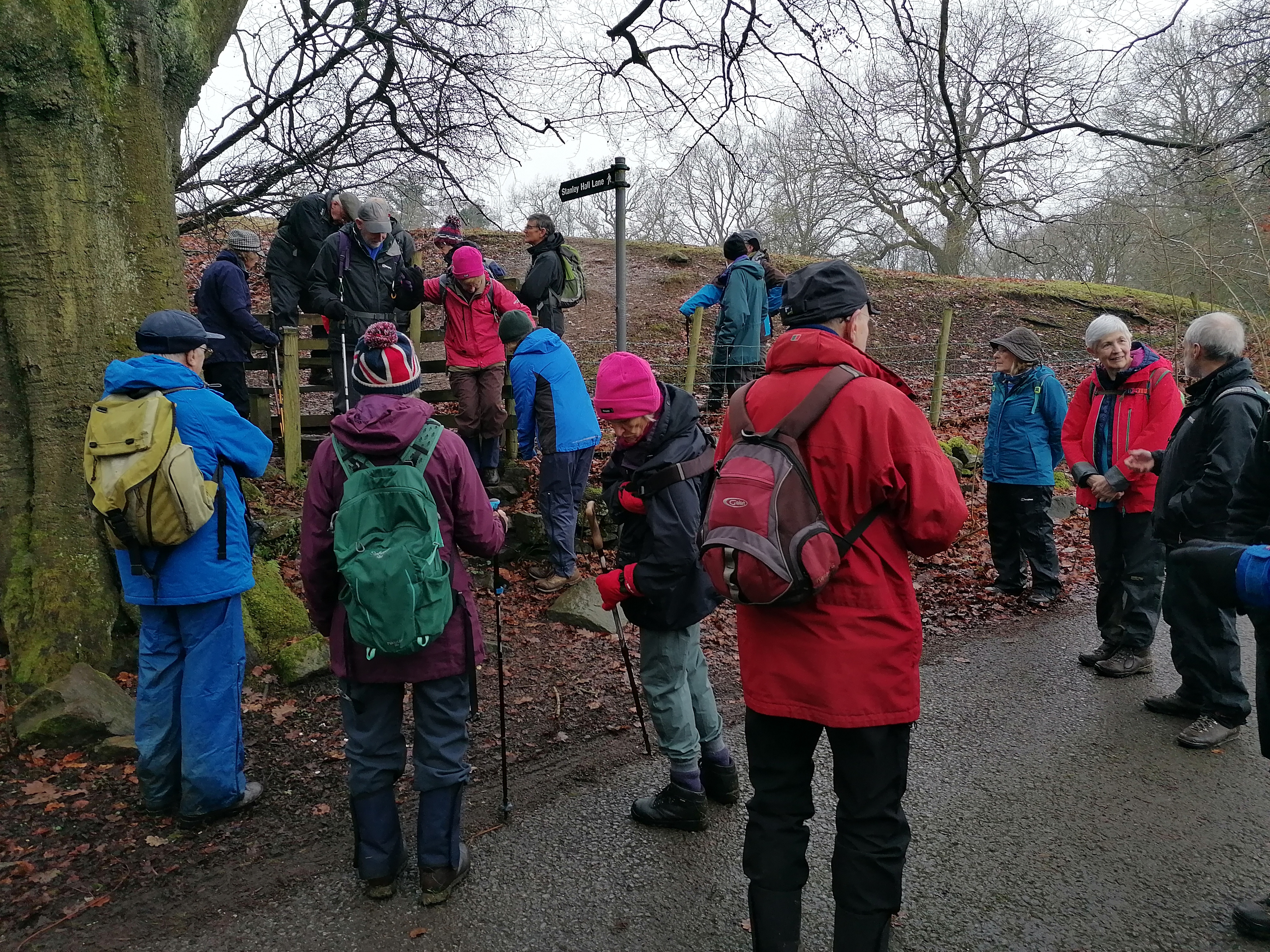
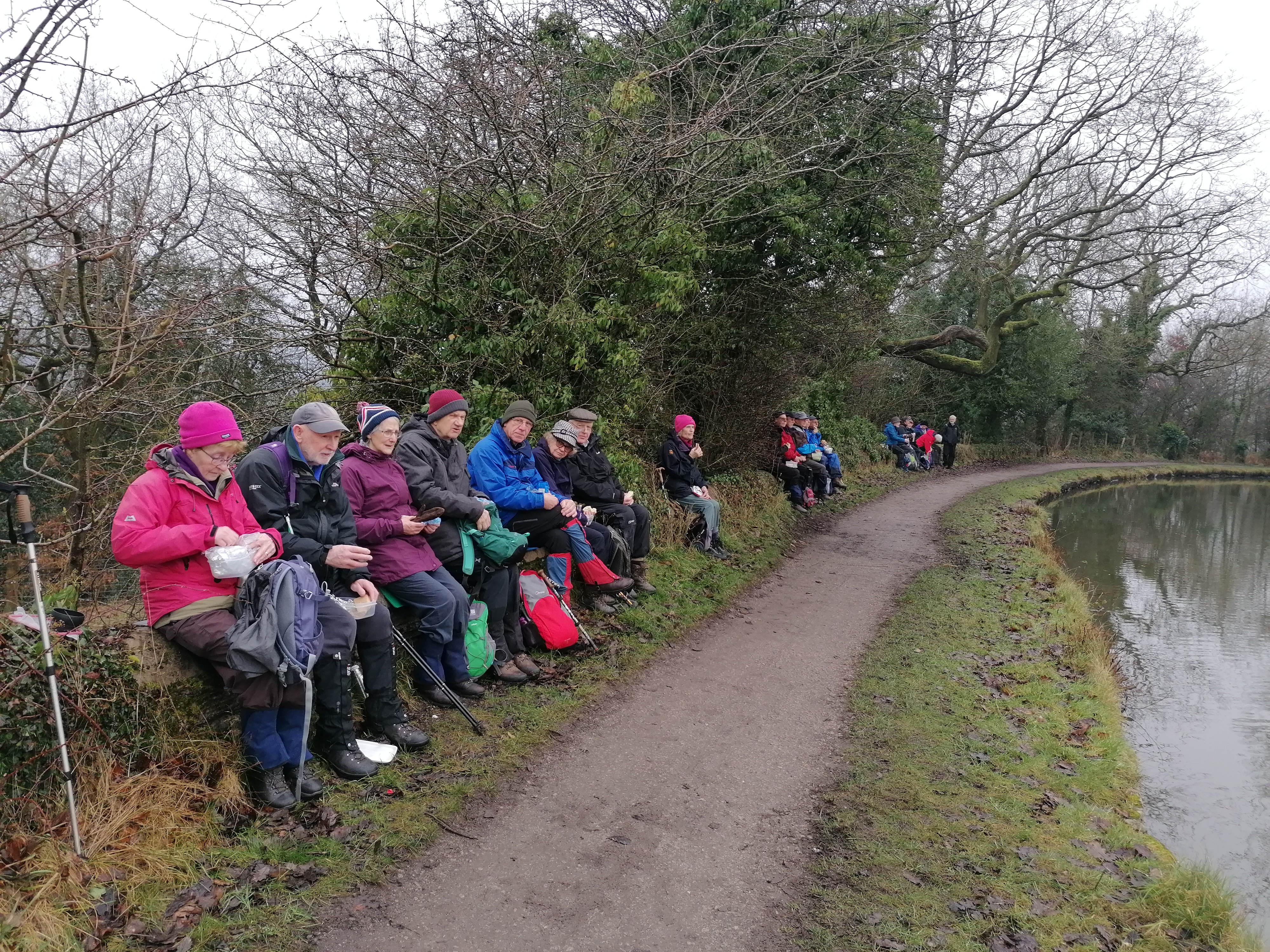
Walking Group report 22nd February
Chadkirk, Midshires Way to Woodbank Park and return via the Alan Newton Way
Alan Newton is the first person born and bred in Stockport to ever win an Olympic medal. Born in 1931 he took part in the 1952 games, 4000 metre Cycling Team Pursuit and won Bronze Medal for GB. The 55 national cycle route spur into Stockport is named in his honour and he opened it in 2016 . He was also invited to open the new bridge across the Goyt which forms a further part of the Connect2 project developed by Stockport Council and Sustrans
Thirty of us met at Chadkirk Country Estate Car Park for a roughly 6 mile walk. We began along a very short stretch of road from the car park to Stockport Hydro, the first community owned hydro electric project in Stockport. We arrived at the site just as someone arrived to undertake routine maintenance and by happy chance one of our number, Steve Reynolds, has connections with the project. We were all duly invited for a guided tour of the facility.
Progressing along the Alan Newton Way we soon reached the bridge over the river Goyt and crossed to the start of the Midshires Way. Our next landmark was Offerton Cricket Club grounds where we should have continued to follow along the river. Unfortunately neglect and recent rain has rendered this section of the Way treacherous and unsafe for more than a mile. This wooded area is criss-crossed by numerous paths, one of which we used to ascend to Woodlands Park on the edge of Offerton. Here we took advantage of sheltered seating for a short coffee break.
We descended through the woods into Woodbank Park at Woodbank Hall. The hall was built in 1812 by Thomas Harrison in Greek revival style for a local cotton manufacturer Peter Marsland. It is in very poor state of repair and appears to have been abandoned by Stockport Council.
On leaving the hall we walked on the connecting path into Vernon Park. This park was built by Stockport Corporation on land donated by George John Warren (Lord Vernon). Work was given to the many unemployed mill workers of the time and it became known as Pinch Belly Park due to their hunger. A pleasant, sunken garden by Vernon Hall provided an ideal spot for lunch.
Suitably refreshed we descended to the river and crossed the new bridge onto the Alan Newton Way. Skirting around the impressively large electricity substation serving Stockport we had a short gentle ascent up to Bredbury Hall. The manor of Bredbury is mentioned in the Domesday book, but Bredbury Hall was only built around 1570. Over time it was neglected and eventually became a farmhouse. It is now a well known hotel and country club.
We continued along the Alan Newton Way, passing through Middle Farm, to Goyt Hall. This hall was built for one Randle Davenport, also around 1570. Altered and rebuilt c.1860 by R. Horsfield it is now a working farm and Grade II Listed Building.
A further level stretch of well maintained path and we rejoined our outward route back to the starting point at Chadkirk.
Ron Rennell
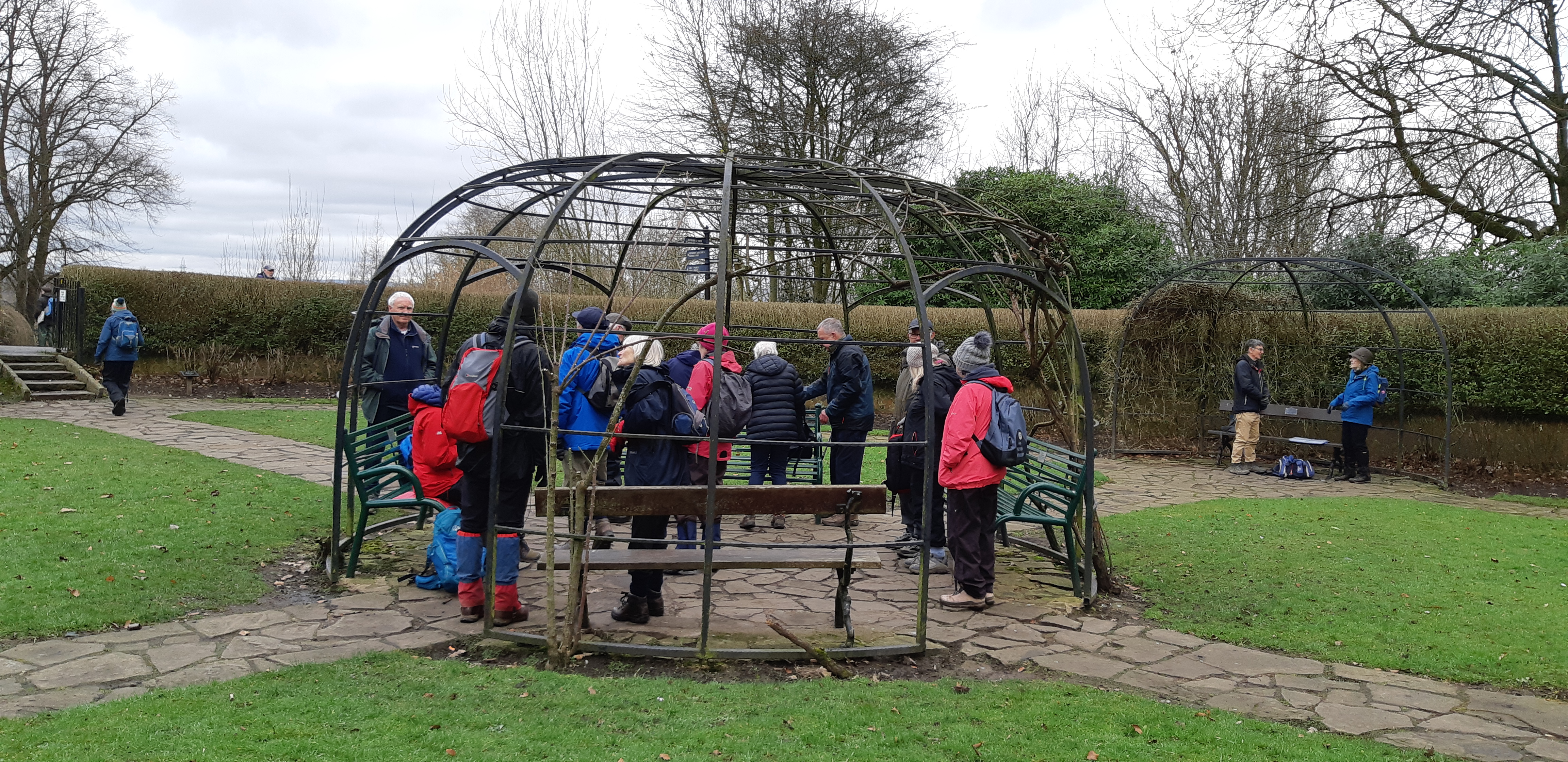
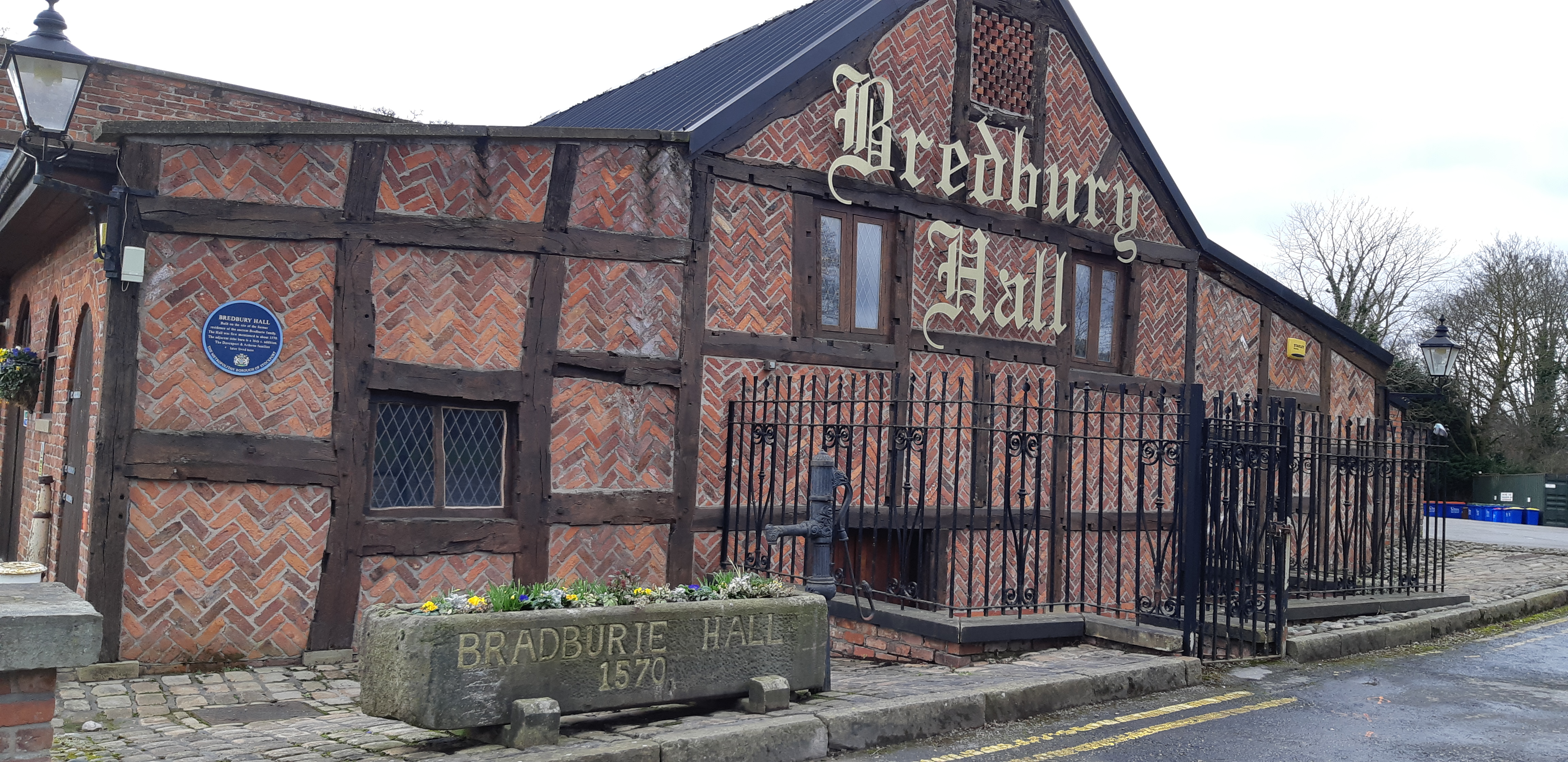
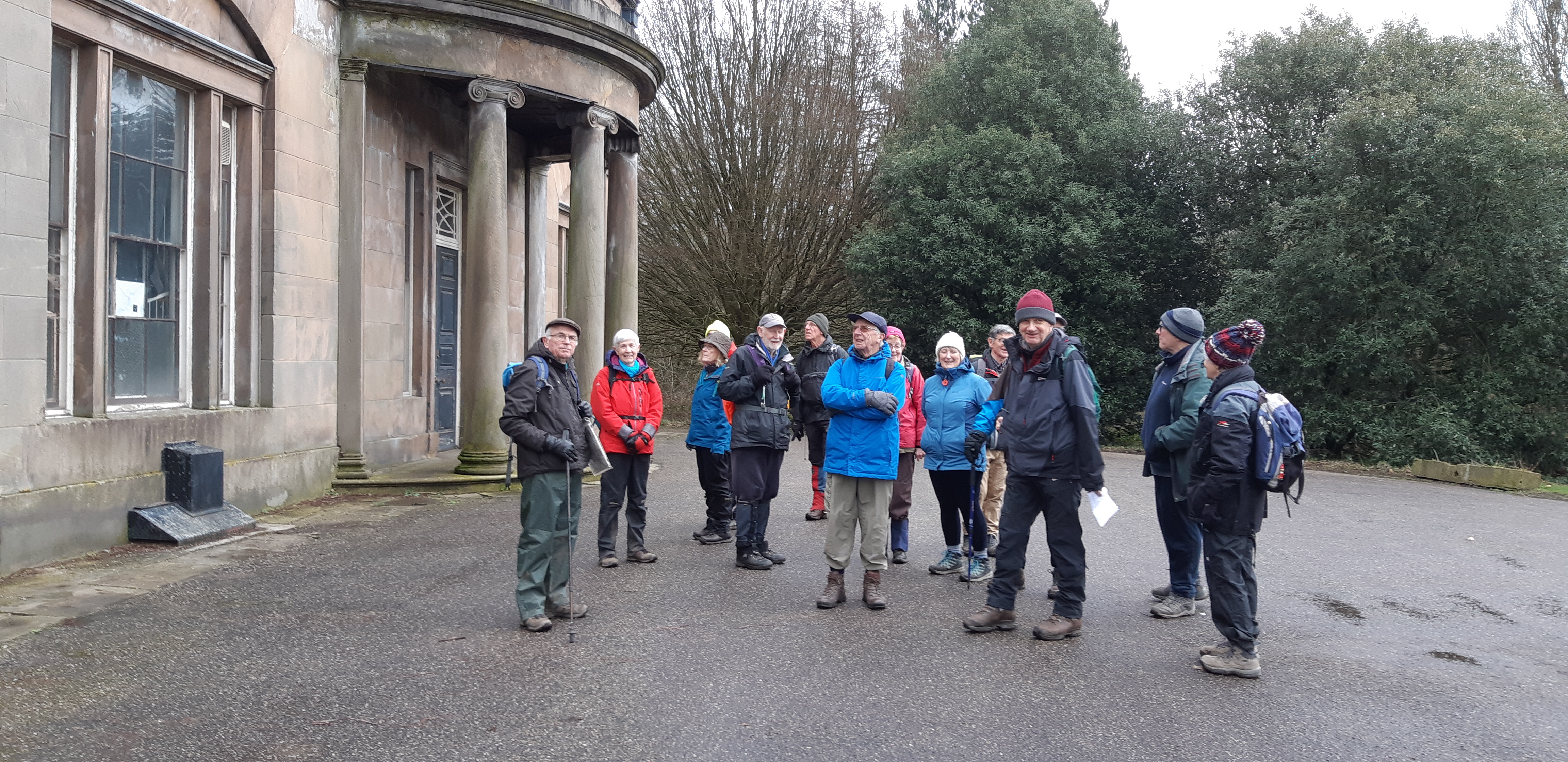
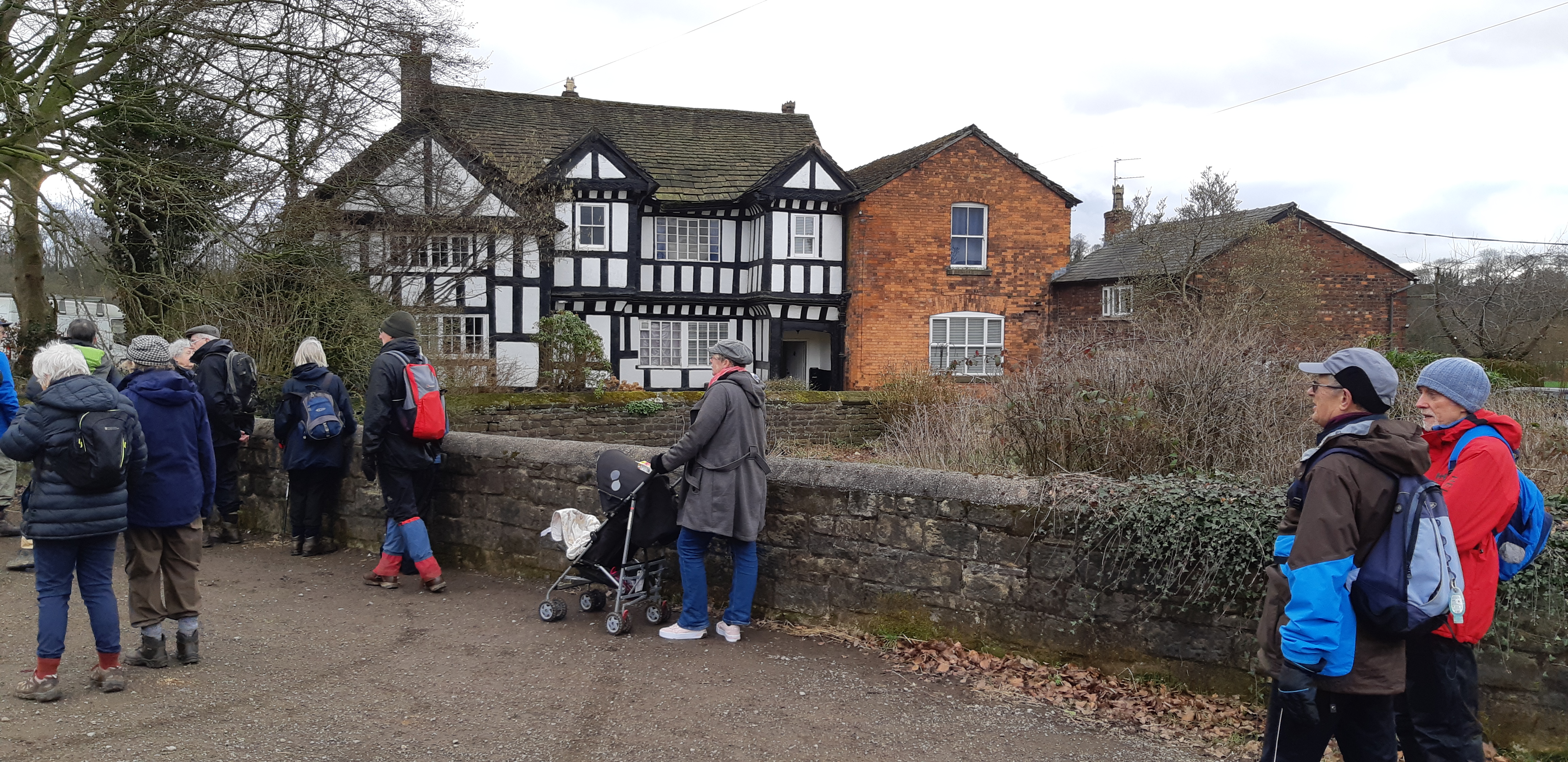
Walking Group report 29th March
Marple, Brabyns Park, Marple Bridge, The Garden House, Roman Lakes, Peak Forest Canal.
On a grey mild end of March day, 23 people covered 5.5 miles on a circular walk along the River Goyt and Peak Forest Canal. The mighty Goyt was clearly visible, without green vegetation to hide its secrets.
We had a lunch stop on the old site of Mellor Mill, now only the ground level remains, which is a very interesting industrial revolution site, which, thanks to recent endeavours by a local history group, now defines and illustrates the life story of Mellor Mill and its remarkable original owner, Samuel Oldknow. Mellor Mill was built in 1790 and was, at the time, the largest cotton spinning mill in the world! At its peak in 1804, 550 people were employed. For 60 years the mill was water driven, the first prime mover was the "Wellington Wheel", 22 ft. in diameter X 17 ft. wide. The wheel pit has been exposed and viewing platforms provide easy access. In 1815 the "Waterloo Wheel" was added to provide more power. The whole Mellor Mill and Mellor Lodge (home of Samuel Oldknow) area provides a fascinating insight into the industrial revolution and the part played by the mighty River Goyt. A visit is recommended.
Our onward route, passing the mill water reservoirs (Roman Lakes) fed from the Goyt, led to a pack-horse bridge over the river and our only serious ascent on the walk, up to the Peak Forest Canal and our easy route back to Marple.
A fascinating local walk, our warm enthusiasm only mildly tempered by a light short shower on the home leg.
David Burke
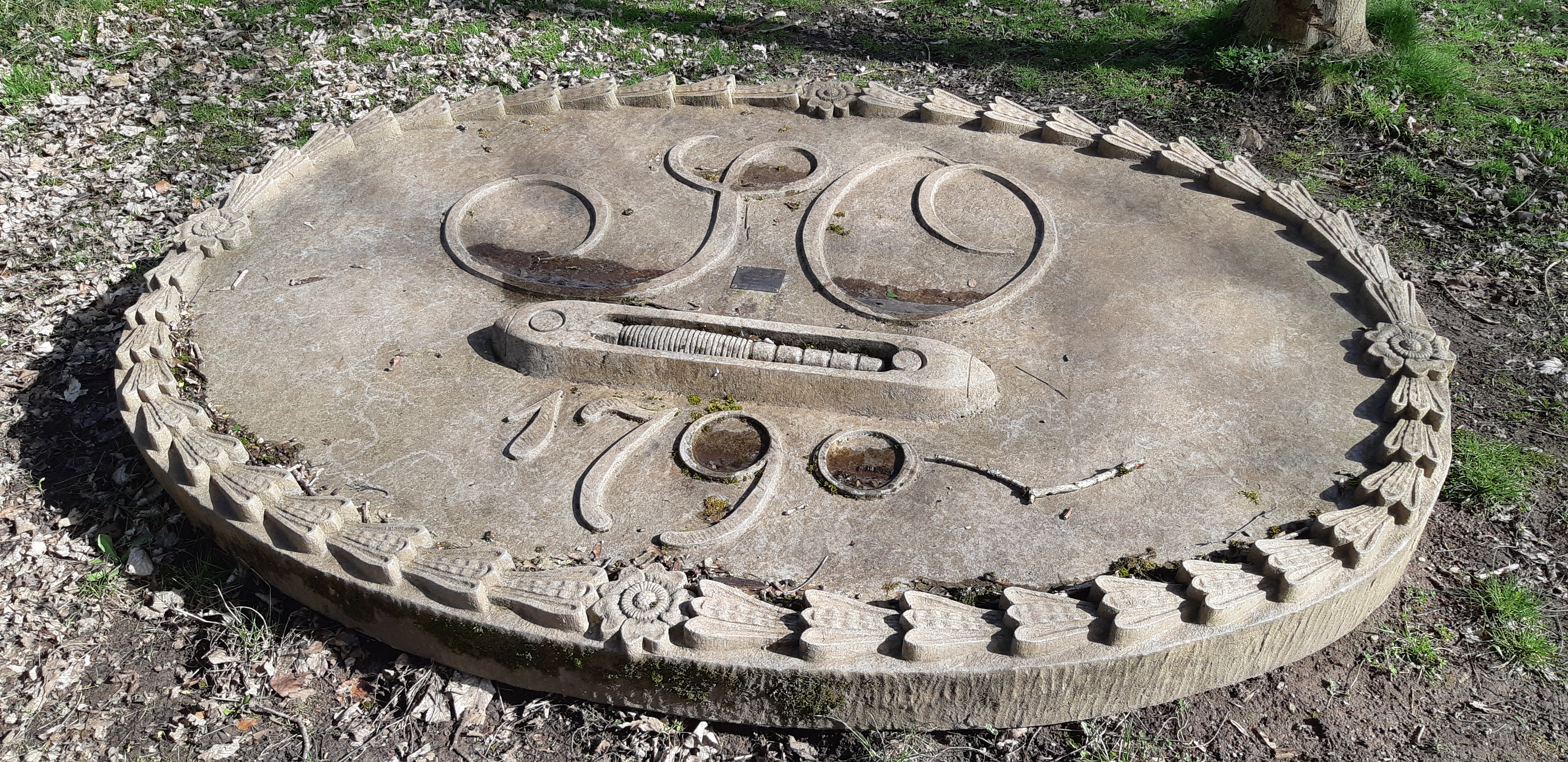
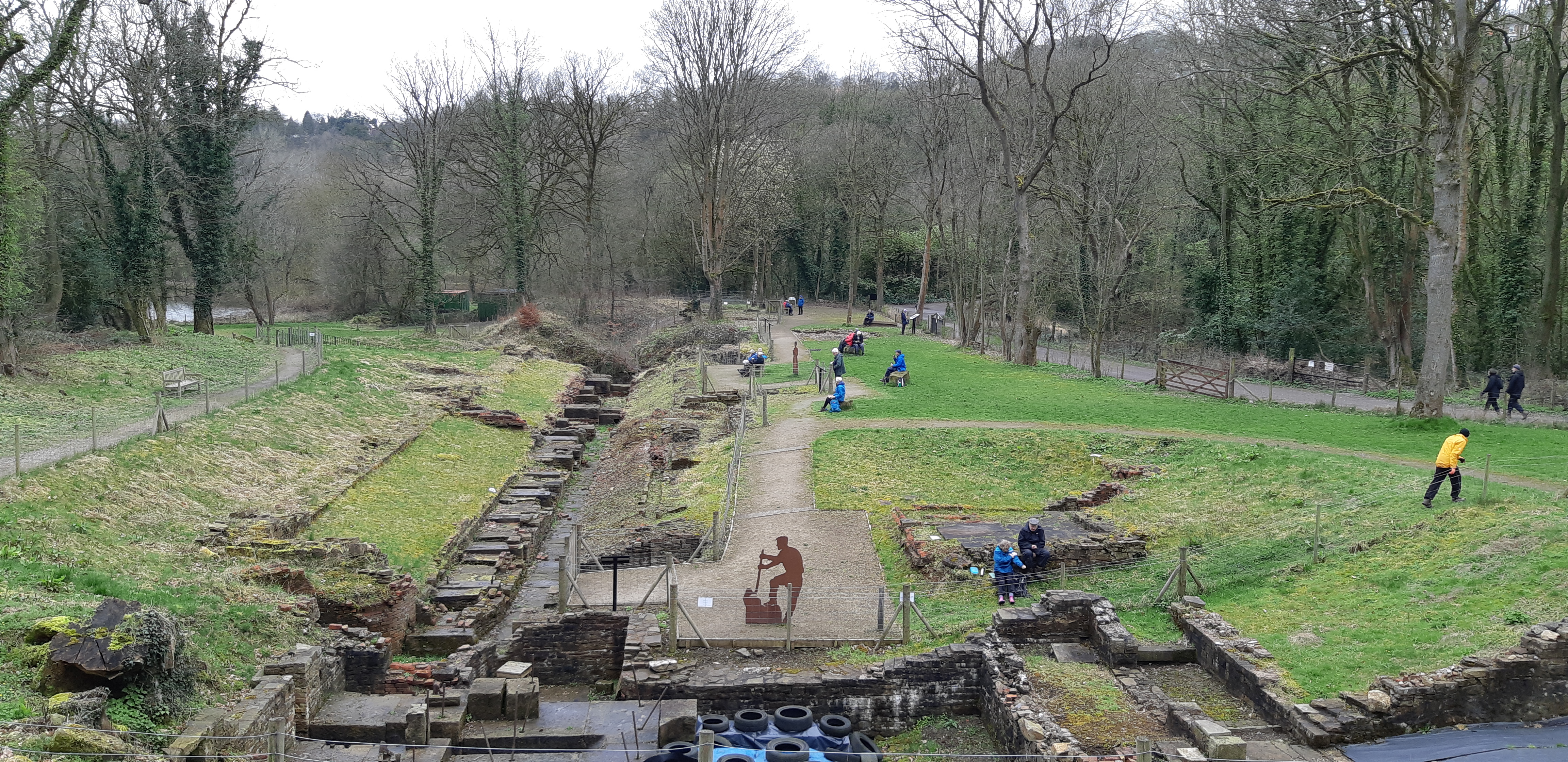
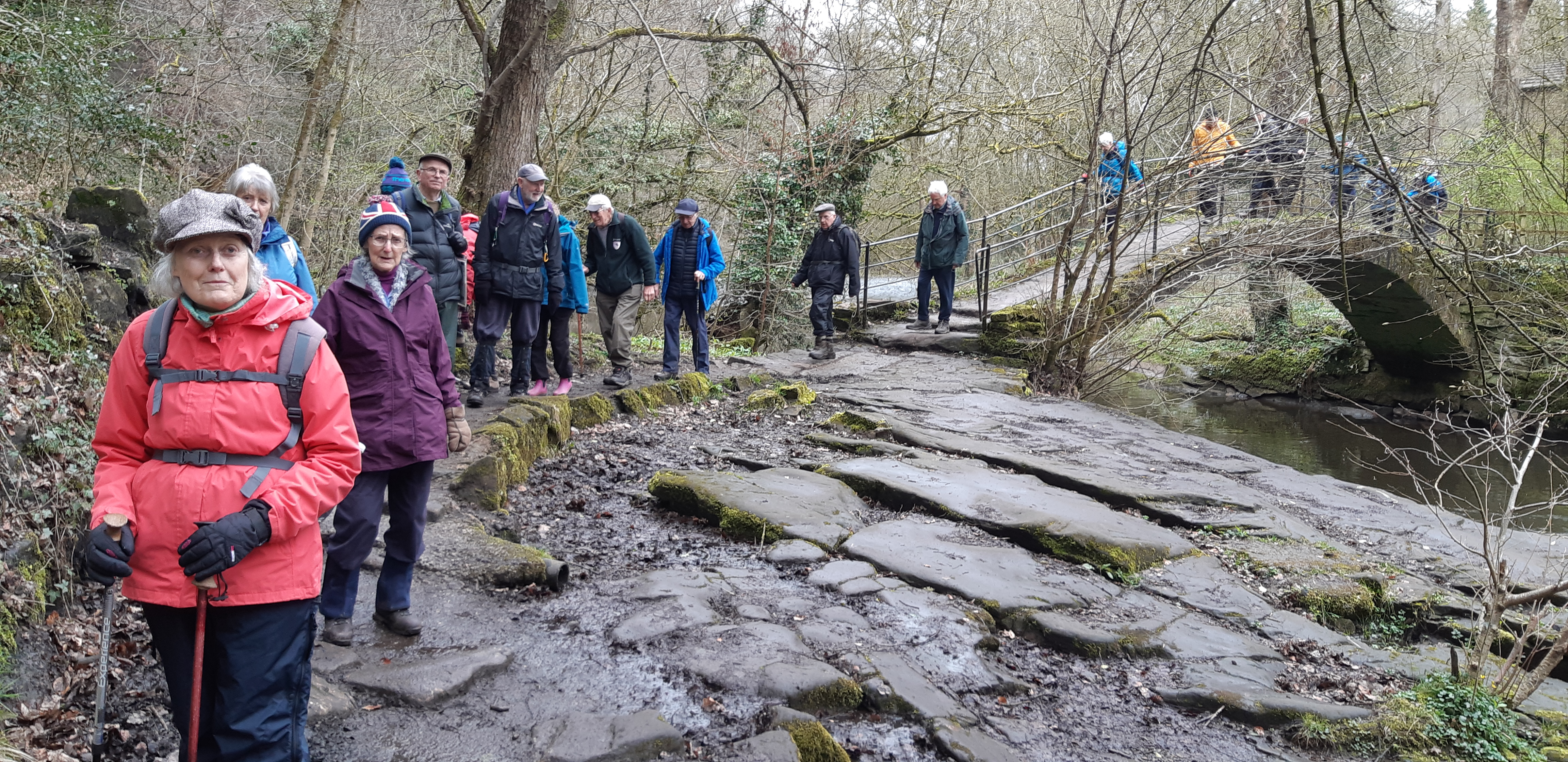
Walking Group report 26th April
Wormhill, Hargate Hall, Dale Head and Peter Dale.
Our April walk in Derbyshire, led by Ruth and Dave Smith, attracted 23 people. Initially, we enjoyed a bright start in weak sunshine, whilst visiting the ancient parish church of St Margaret in Wormhill. Alas, duller conditions developed later, however the day remained rain free.
Wormhill and district feels isolated in former times with little change, after all, it got a mention in the Domesday book! Our onward progress to Hargate Hall was hampered by very slim pinch stiles, set in a succession of limestone walls. Peter Dale, always a delight, was equally quiet, we had it to ourselves.
An enjoyable and interesting walk, we must venture into the High Peak again soon, now that Spring has sprung!
David Burke
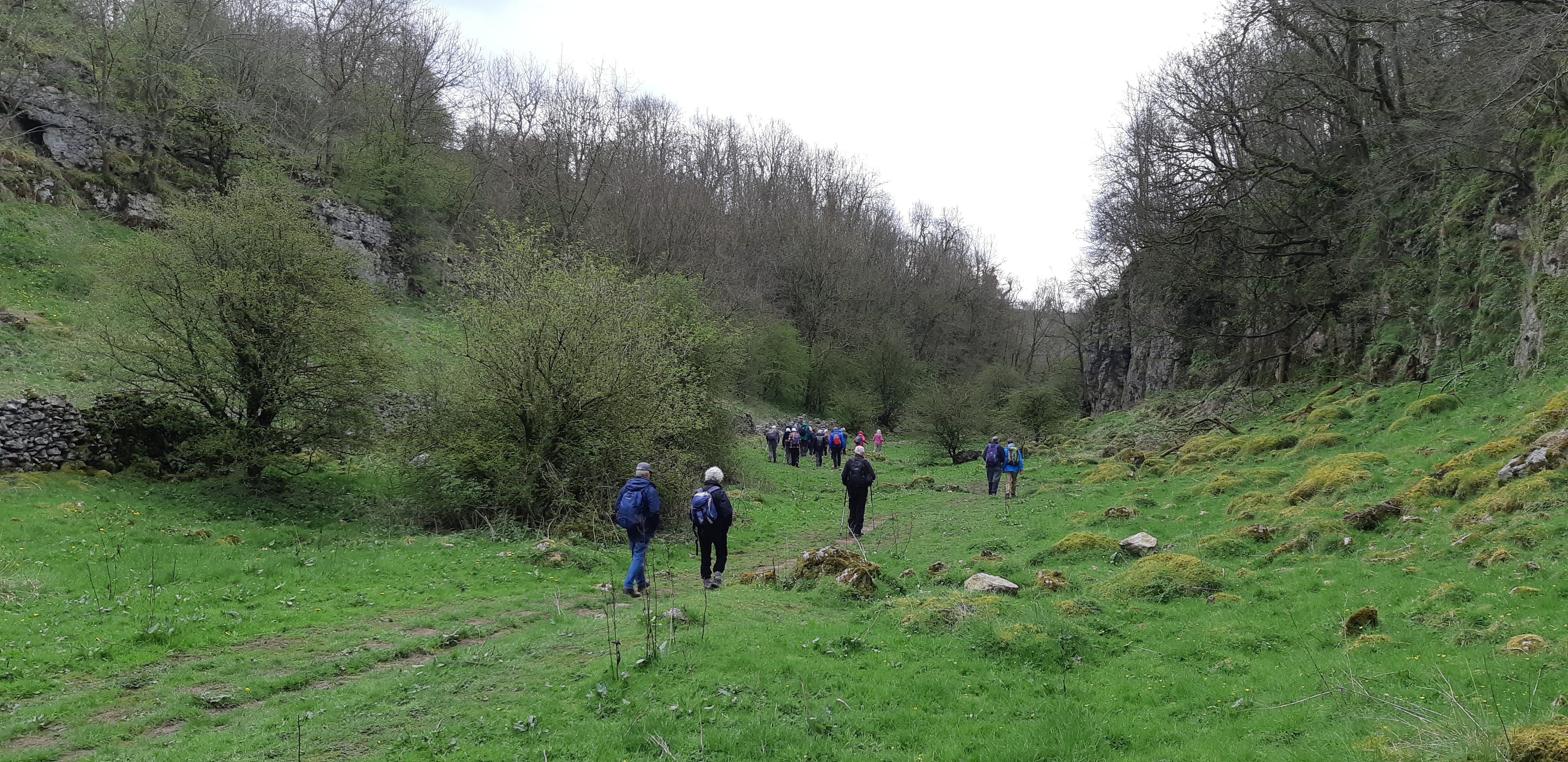

Walking Group report 24th May
On a perfectly sunny morning 18 walkers set off for Ashford in the Water in the White Peak district. We met at the “sheep wash bridge” a scheduled monument on the river Wye .The 12-century village of Ashford grew up at the fording point of the river where ash trees grew and hence the name which is mentioned in the Domesday Book.
The first part of the walk was through the village, then passing the old water power Corn Mill dated from 1086.We followed the river as it meandered through lush meadows looking at the hillside above until we came to “Ashford Lake” where we had our coffee stop. The river had been changed just passed here with dams, embankments mill ponds and weirs for powering the cotton mill below.
Next stage we reached Lumford Mill a former cotton mill built by Richard Arkwright in 1777 and managed by his son Richard Arkwright junior. Merlyn gave a detailed mill history and further told of the industrial history of Ashford, woollen mills, corn mill, lead mining, lime kills, Black Marble mines and water powered mill for finishing the marble, comb mills old grand Halls and now it's mostly tourists.
We left the river behind at the end of the Lumford cottages and headed upwards past Holme Hall a large stone-built hall from 1627 which is grade 1 listed. Behind the hall we saw old stone working equipment possibly associated with Holme Hall “chert “quarry and mine just ahead. The wide grassy path climbed very steadily up past the many fields covered in an abundance of grass, buttercups and many wild flowers identified by some of walkers on a google picture APP.
A leisurely Picnic Lunch was taken near the top of this path amid glorious views to Hassop, Curbar Edge, and Calver and nearby Great Longstone.
Refreshed we continued downhill passing fields of many cows with their young calves also enjoying the new pasture and sunshine. Shortly joining the Monsal trail for about 15mins before leaving for our route through the Churchdale Estate back to Ashford in the Water. This estate, land, lodge, farm and grand hall dates from 1550 built for Henry Neville the earl of Westmoreland and subsequently purchased by the Duke of Devonshire.
Arriving back at exactly 3pm as predicted the grouped thanked Merlyn & Joyce for a great walk.
Merlyn and Joyce Young
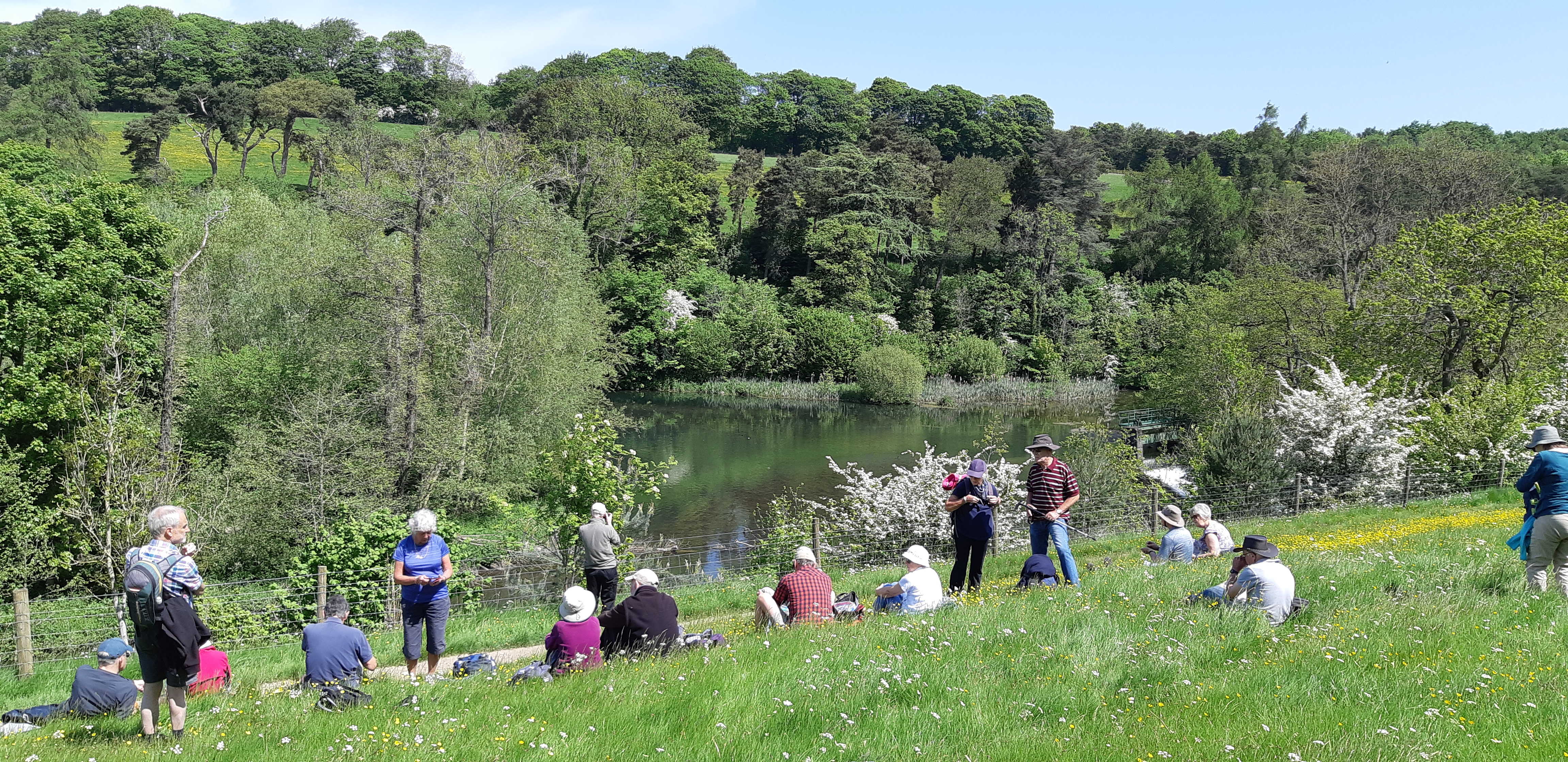
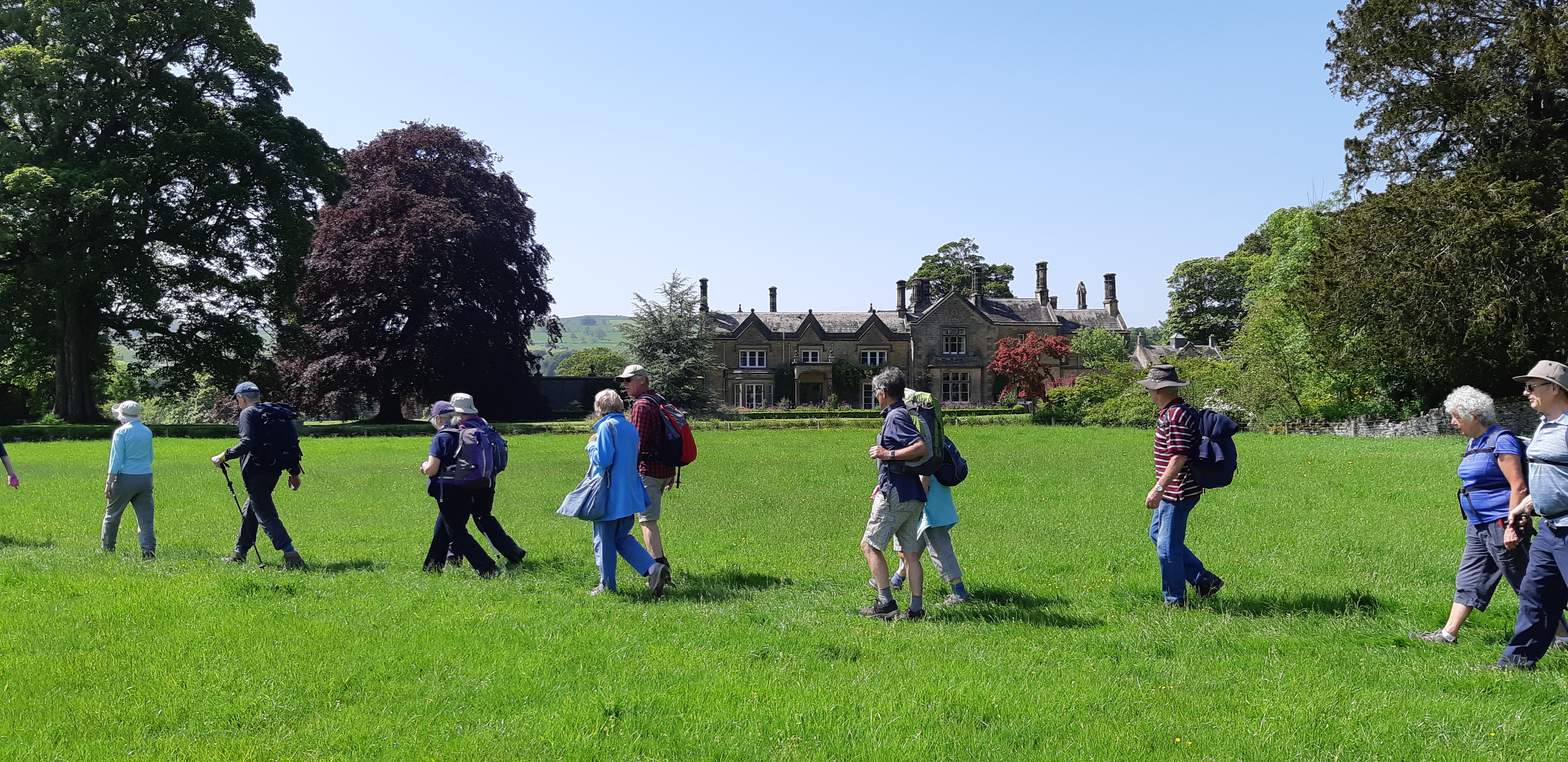
Walking Group Holiday 5 - 8 May 2023. Coniston. Lake District
Eighteen people attended this 4-day walking holiday to the Lake District seeking our usual blend of mystery, suspense and adventure! We stayed at Monk Coniston Hall which is situated at the Northern end of Coniston Water and just over one mile from Coniston village.
Monk Coniston Hall, a Gothic-style property dates from the 1770's, in 1836 it was purchased by a wealthy Leeds industrialist who hugely extended and improved the property. He entertained eminent friends such as Thomas Carlyle, Adam Sedgewick, Alfred Tennyson, John Ruskin and Lewis Carrol. Beatrix Potter purchased the entire estate in 1930 to save it from development and bequeathed the property to the National Trust and is now leased to HF Holidays. The grounds include extensive gardens, an arboretum - some trees planted in the early 19 th century, and a walled kitchen garden. One of the very large trees has a deep cavity at its base which is said to have inspired Lewis Carrol when writing Alice in Wonderland!
MONK CONISTON
.jpg)
Friday 5 th May: Arnside Knott, Morecombe Bay
On our journey to Coniston, we stopped at Arnside for a 4-mile coastal wall. We met at the National Trust Car park on Arnside Knott, which is a wildlife-rich coastal landscape of grassland, woodland and rugged limestone pavement and provides spectacular views over Morecambe Bay and beyond.
After climbing to a panoramic viewing point, we descended through pleasant woodland to sea-level and enjoyed a picnic lunch on a pebbled beach. At the end of the coastal section of the walk we stopped at a cafe where refreshments were taken, in pleasant sunshine, the dry weather had improved as the day progressed. After a short uphill climb we returned to our vehicles to continued our onward journey to Coniston.
After checking-in to our accommodation, Monk Coniston Hall, we enjoyed a welcoming cream tea which set the tone for our stay, the friendly hardworking staff provided excellent service throughout.
ARNSIDE KNOTT

Saturday 6 th May: Tarn Hows, Cumbrian Way, High Oxen Fell, Holme Fell, Yewdale, Brown Crag Farm
A dry, bright, sunny day enhanced our 7.5-mile circular walk, starting directly from Monk Coniston we passed through very pleasant woodland on a steady rising incline to Tarn Hows, one of the Lake Districts picturesque gems. After a coffee stop at a viewing point above the Tarn, we proceeded northward on the Cumbrian Way to High Oxen Fell followed by old Quarries reclaimed by nature, which provided us with a pleasant picnic lunch spot, we then followed the river along the flanks of Holme Fell, Yew Band, Raven Crag, Calf Crag to Shepards Bridge. Across flat fields through Yewdale onward to Boon Crag Farm and back to Monk Coniston.
After dinner, on this Coronation day, our evening entertainment included Royal Quiz, aided and abetted by our all-inclusive drinks package!
TARN HOWS

Sunday 7 th May: Coniston, Wild Cat Island Cruise/Ferry , Coniston Water, Sunny Bank, Coniston Shore.
Another bright sunny day starting direct from house on a pleasant walk to Coniston jetty to catch the ferry to Sunny Bank, situated at the South end of Coniston Water, to join the picturesque shore-side path back to Coniston village and then the home stretch back to Monk Coniston. On the way back to Monk Coniston we happened upon 3 black Herdwick lambs on the wrong side of a gate, they found it easy to escape from the field but clueless at getting back! After a bit of a performance and a couple of rugby tackles, we managed to reunite them with their anxious mothers.
It's worth a mention, whilst in Coniston village on the way back, we all had a welcome sit down and our athletic superman member, Rick Hedley, decided to have an impromptu go at The Old Man of Coniston, knowing the weather window for some of us to attempt a quick ascent the next day, was not going to be feasible with bad weather and a low cloud base. Rick made it to the top and back in a remarkable 3 hours!
After dinner entertainment included a "Coronation" wildflower seed sowing session and an international mountain slide show.
CONISTON WATER

Monday 8 th May: Little Langdale and Cathedral Quarry
Alas, our luck with the weather changed to full on wet! Everyone did their own thing and the few that had intended an attempt on The Old Man of Coniston settled for a shorter walk to Little Langdale to visit Cathedral Quarry, a legacy from the slate industry, it is a massive hole in the ground that has to be seen to be believed!
CATHEDRAL QUARRY

To summarise, our friendly group had a fantastic 4-days away, blessed with great weather for walking (except Monday). We saw and did many things, it felt that we had been away much longer than the time we had, all etched within our minds, coupled with our usual blend of mystery, suspense and adventure!
David Burke
Walking Group report 28th June
Ashford-in-the-Water to Magpie Mine and Sheldon.
In spite of the threat of showers and the possibility of heavier rain later, 19 hardy U3A walkers set off from the sheepwash bridge in the
pretty village of Ashford-in-the-Water in Derbyshire.
After crossing the busy A6, we climbed steadily on a well-made path with
vistas which improved continuously as we headed towards the antenna
overlooking Ashford.
Reaching the top of the hill after an ascent of around 350 feet, we
stopped awhile for coffee on a grassy knoll.

After a short section walking on a quiet road past an ash tree
plantation, we followed a farm track on to the plateau on which the
Magpie Lead Mine is situated.
Magpie Mine was the last working lead mine in Derbyshire and is
acclaimed as the best preserved 19th century lead mine in Britain. Some
of the mine workings dating back to the 17th and 18th centuries.
Although it is not possible to go explore any of the underground
workings, we were able to explore the many interesting examples of
industrial archaeology which may be seen on the site, such as the
Cornish Engine House (1869) and it's adjacent circular chimney
(originally 1840), the 728ft deep Main Shaft, head gear and cage,
winding drum, the Powder House (1840), the Shuttlebark engine shaft
(1760) and the Agents House and Smithy (1840).
After lunch at the Magpie Mine site, we set off across several fields
towards the village of Sheldon nearby.
Having observed the approach of some dark rain clouds we donned our wet
weather gear and having walked through Sheldon we adjourned to the Cock& Pullet pub for refreshments, and to let the rain pass by!
.jpg)
It was originally planned to drop down to the water outflow (sough) from
which the Magpie Mine workings still pour some 4 to 6 million gallons of
water daily into the river Wye; however, in view of the possibility of
more rain to come it was decided to descend more directly back to our
starting point at Ashford-in-the-Water.
.jpg)
The total distance walked was about 4 miles.
Rick Hedley
Walking Group report 26th July
Castleton, Cave Dale and Winnats Pass
On this sunny pleasant end of July day, seven walkers enjoyed this 4.25-mile Peak District walk, steeped in history, mystery and suspense. Castleton was established in the eleventh century, after the Norman conquest. The Royal Forrest of the Peak and valuable lead mining interests were presided over by the King's bailiff, William de Peveril, from his bastion above Peak Cavern. Castleton is located on the interface between the White and Dark Peak Districts.
We left Castleton via Cave Dale, which has eight caves, on a steady climb up a rough path which led to improved grassland walking terrain, towards the top of the Dale. Interestingly, Cave Dale has been the source artifacts from the Stone Age and Bronze Age. Looking back down Cave Dale we were rewarded with an excellent view of the remains of Peveril Castle hiding behind trees on the skyline.
.jpg)
On this sunny pleasant end of July day, seven walkers enjoyed this 4.25-mile Peak District walk, steeped in history, mystery and suspense. Castleton was established in the eleventh century, after the Norman conquest. The Royal Forrest of the Peak and valuable lead mining interests were presided over by the King's bailiff, William de Peveril, from his bastion above Peak Cavern. Castleton is located on the interface between the White and Dark Peak Districts.
We left Castleton via Cave Dale, which has eight caves, on a steady climb up a rough path which led to improved grassland walking terrain, towards the top of the Dale. Interestingly, Cave Dale has been the source artifacts from the Stone Age and Bronze Age. Looking back down Cave Dale we were rewarded with an excellent view of the remains of Peveril Castle hiding behind trees on the skyline.

Our onward route along Long Cliff led to the Goosehill area of Castleton where we visited the entrance to the mighty Peak Cavern with the spectacular vertical limestone cliff faces supporting Peveril Castle above. William de Peveril picked a good spot for his stronghold.
We rewarded ourselves with a well-earned Bradwell's ice cream before leaving Castleton as the rain clouds started to gather!
David Burke
Walking Group report 30th August
Pym Chair, Cats Tor, Shining Tor, Shooter's Clough, Errwood Hall, Foxlow Edge
On this changeable but pleasant end of August day, fourteen walkers enjoyed this 5-mile Peak District walk, steeped in history, mystery and suspense. Mystery - because low cloud surrounded us as we left Pym Chair carpark following the path to Cats Tor. The strong breeze opened and closed views of the distant horizon, giving us glimpses of the fantastic panoramas to come as the low cloud disappeared on the persistent breeze.
On reaching Shining Tor we stopped for coffee - enjoyed a welcome rest and ever improving visibility. The 360-degree impressive landscape was there to behold.
Our onward route towards the Goyt Valley was highlighted with sunny spells and very clear distant views. Shooters Clough provided a change of landscape leaving the moorland and heather behind, replaced with ancient woodland in the steep sided valley.
The ruins of Castedge Farmhouse provided an idea sunny spot for a picnic lunch, with good seating on the rubble remains. This pretty spot lay below the small hill housing Errwood Hall Burial Ground. Our final climb up Foxlow Edge led to St. Joseph's Shrine before joining The Street leading to Pym Chair carpark and a well-earned sit down!
David

.jpg)
.jpg)
.jpg)
Walking Group report 27th September
Bollington, Macclesfield Canal, River Dean Valley, Waulkmill Waterfall, Rainow, Oakenbank
This 5-mile walk led by Ed Rowbottom was full of pleasant surprises - beautiful landscape - fascinating industrial archaeology - ever changing interesting scenery.
The route had a few short ups and downs in keeping with the undulating character of the area and several easy gate stiles and some ancient stone pinch stiles, all easily negotiated by the 23 attendees.
Walking surfaces were good and sound, one long field had a paved pathway - initially laid for the millworkers' benefit. The dry bright weather conditions at the start of the walk slowly deteriorate as the wind strengthened but mercifully the serious rain came after we had finished!
David Burke

.jpg)
.jpg)
Walking Group report 25th October
Hayfield, Sett Valley Trail, Lantern Pike, Blackshaw Farm, Little Hayfield, Park Hall Wood, Middle Moor, Hayfield.
On a surprisingly sunny late October walk, led by Ian Hope and Jeff Robinson, nineteen walkers enjoyed a 6-mile challenging circular walk starting from The Royal Hotel carpark in Hayfield.
Conditions on the day were glorious! Sunshine throughout with very little breeze and clear horizon searching views. A day to remember!
The route had a few short ups and downs in keeping with the undulating character of the area - beautiful landscape - moorland heather - spectacular scenery. An inspiration to lift our spirits at this time of year.
David Burke

.jpg)
.jpg)
.jpg)
Walking Group report 29th November
FIVE HALLS WALK CHAPEL EN LE FRITH
On a very crisp, frosty Wednesday morning, 20 walkers arrived for a 6 mile walk in Chapel. Steve and Sandra Barber led the walk starting near the market place.
Our first point of interest was St Thomas Becket Church dating back to 1225 and in 1648 held 1000 Scottish prisoners taken by Cromwell in the Battle of Preston for 2 weeks, unfortunately 44 of them died and earned the church the title Derbyshire Black Hole. We then went through a small amount of housing heading to Bowden Hall. Bowden Hall was built in the first half of the 19 th century and has a lovely clock face originally in the church. The route then went uphill to a lovely hamlet called Malcoff. From there we proceeded to Ford and Ford Hall. Ford is believed to be the oldest part of Chapel. The Hall dates back to Henry 111 (1216 - 1272). The Hall is now 3 houses. Onwards to Slack Hall, in lovely sunshine, and we stopped for lunch. Slack hamlet for several centuries was a Quaker stronghold. When the owners of Slack Hall, in the 1800, found that there was to be a turnpike road which would cut through his garden, he built a new residence near Chapel. It was then up to Stoneyford towards Bagshawe Hall. We had ice on the path going down to the Hall - everybody handled it well. Bagshawe Hall is now a farm dating back to the 14 th century. The last hall, New Slack Hall, was quite a way from the path and is known locally as Pretty Fields. From there we went along the road back to Chapel.
Sandra Barber

.jpg)
.jpg)
Walking Group report 13th December
On a fine bright day in December, 23 walkers, led by Ruth and Dave Smith, enjoyed a 3.5 mile circular walk starting from The Sycamore Inn at Thornsett near Hayfield.
Conditions on the bright day were good, intermittent sunshine throughout, with a light breeze and no rain!
Cherry liquors were distributed at our coffee stop to celebrate our final walk in 2023. A very pleasant December walk as a precursor to our Christmas lunch at the Sycamore Inn, where we were made to feel very welcome by the staff and enjoyed an excellent lunch - well worth another visit.
Our thanks to Ruth for arranging the event - a day to remember! An inspiration to lift our spirits and prepare us for Christmas and the New Year.
May I convey my thanks to all members and walk leaders who have supported the walking programme throughout 2023.
David Burke